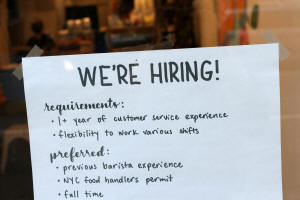Fed's 'inclusive' jobs promise hits reality of inflation control
 Send a link to a friend
Send a link to a friend
 [January 06, 2023] By
Howard Schneider [January 06, 2023] By
Howard Schneider
WASHINGTON (Reuters) - Aiming to fortify broad labor market gains among
U.S. minority groups over the previous decade, Federal Reserve Chair
Jerome Powell in 2020 engineered a historic promise to try to maintain
that progress by giving "broad-based and inclusive" employment a status
equal if not superior to the central bank's pledge of low inflation.
Amid a still-raging escalation in prices, however, that commitment has
taken a blow. Officials at the Fed's Dec. 13-14 policy meeting
acknowledged an economic slowdown needed to thwart inflation also meant
"the unemployment rate for some demographic groups - particularly
African Americans and Hispanics - would likely increase by more than the
national average."
It was a stark admission that highlights the dilemma the Fed faces as it
balances a battle with the worst outbreak of inflation since the 1980s
against possible damage to the second goal of its "dual" mandate: full
employment across society.
New data on Friday is expected to show 200,000 jobs were added in
December, about double what the Fed feels is sustainable, with wages
rising and unemployment rates for Blacks and Hispanics at or near
record-low levels. The longer that job market strength persists, the
more Fed officials may feel compelled to break it with ever-higher
interest rates.

"The view that labor markets remain too tight is the consensus shared by
both hawks and doves," Tim Duy, chief U.S. economist at SGH Macro
Advisors, wrote following the release on Wednesday of minutes from the
December meeting that he felt showed the Fed "willing to bear the costs"
of forcing the unemployment rate higher.
"I don't think we can understate the importance of labor market
outcomes," Duy wrote. "If the labor market doesn't soon slow markedly,
the Fed will need to push policy rates" beyond the 5.00%-5.25% range
most officials now see as an endpoint.
The target federal funds rate is currently set in a range of 4.25% to
4.50%.
'SURGE PRICING'
The job market has befuddled central bankers during the COVID-19
pandemic as much as inflation. Early expectations that a flood of
workers back into the labor market would ease wage and hiring conditions
proved optimistic. The labor force participation rate has stalled below
its pre-pandemic level and some officials feel supply "appears to be
constrained," the December meeting minutes showed.
Even with uncertainty surrounding the economy, demand to hire remains
strong. There are still far more job openings than people looking for
work.
Though that is a possible recipe for steadily rising wages, the Fed's
focus on the labor market as a possible driver of future inflation is
not without controversy.

Some economists and policymakers have argued the sources of inflation
lie elsewhere and shouldn't require dramatically higher unemployment to
fix. Fed Vice Chair Lael Brainard has cited still-large corporate profit
margins, for example, while Minneapolis Fed President Neel Kashkari
recently likened the current dynamic to the sort of "surge pricing" used
by companies like ride-hailing firm Uber Technologies Inc when high
demand meets unbending supply.
Others argue a full return to 2% inflation may prove harder than
expected, and the cost to growth and employment of the final increment
may prove too high to bear.
[to top of second column] |

A hiring sign is seen in a cafe as the
U.S. Labor Department released its July employment report, in
Manhattan, New York City, U.S., August 5, 2022. REUTERS/Andrew Kelly

The Fed itself projects the unemployment rate rising just about a
percentage point, to 4.6% from the current 3.7%, by the end of 2023,
an increase that would typically be associated with a recession,
though not an excessively harsh one.
The minutes from last month's meeting, however, may be a warning of
what lies ahead, and stand as a blow to the job-friendly framework
formally adopted by the Fed in mid-2020 and crafted with the view
that a strong job market and low inflation can coexist.
That was the case through the record-long expansion that began in
2009 and was still underway when the pandemic hit.
Officials then expected inflation to rise for any number of reasons,
from the Fed's own massive bond purchases to a steadily falling
unemployment rate. It didn't, and remained so persistently low that
policymakers worried they might face Japan's fate, where the central
bank's inability to raise inflation to the 2% target presented risks
of its own.
'WAGE-PRICE SPIRAL'
The new framework aimed to fix that with a built-in bias against
raising rates until inflation had not just returned to the 2% level
but exceeded it, allowing loose credit to power the economy, and
prices, higher. In theory, more jobs and lower joblessness would
also result.
That approach, embodied in policy statements in the critical months
when rising inflation took hold in 2021, has been criticized as
anchoring the Fed to a course of action officials were too slow to
abandon.
Policymakers have acknowledged as much, even as they also argued it
would have made little difference if they had mobilized against
inflation a few months earlier.
What they fear developing now is a different problem altogether:
Inflation that may become driven by the very labor market conditions
they promised to encourage.

The notion of a "wage-price spiral" remains disputed, since
inflation so far has exceeded average wage gains.
But as inflation ebbs from what Fed officials hope will prove a
mid-2022 high point, Powell and others await a moderation in wage
gains too.
The inflation now proving the hardest to uproot is in the
labor-intensive services sector, where prices are most sensitive to
workers' earnings "and therefore would likely remain persistently
elevated if the labor market remained very tight," the minutes
noted. "While there were few signs of adverse wage-price dynamics at
present, (policymakers) assessed that bringing down this component
of inflation to mandate-consistent levels would require some
softening in the growth of labor demand."
That conclusion doesn't mean the new framework is dead. In fact, the
Fed will almost certainly reapprove that approach at its Jan.
31-Feb. 1 policy meeting. Powell has argued the best way to honor
the mandate, in fact, is by controlling inflation now so that a more
sustainable job market emerges.
But the immediate conflict between the two may be growing close.
(Reporting by Howard Schneider; Editing by Dan Burns and Paul Simao)
[© 2023 Thomson Reuters. All rights
reserved.]
This material may not be published,
broadcast, rewritten or redistributed.
Thompson Reuters is solely responsible for this content. |